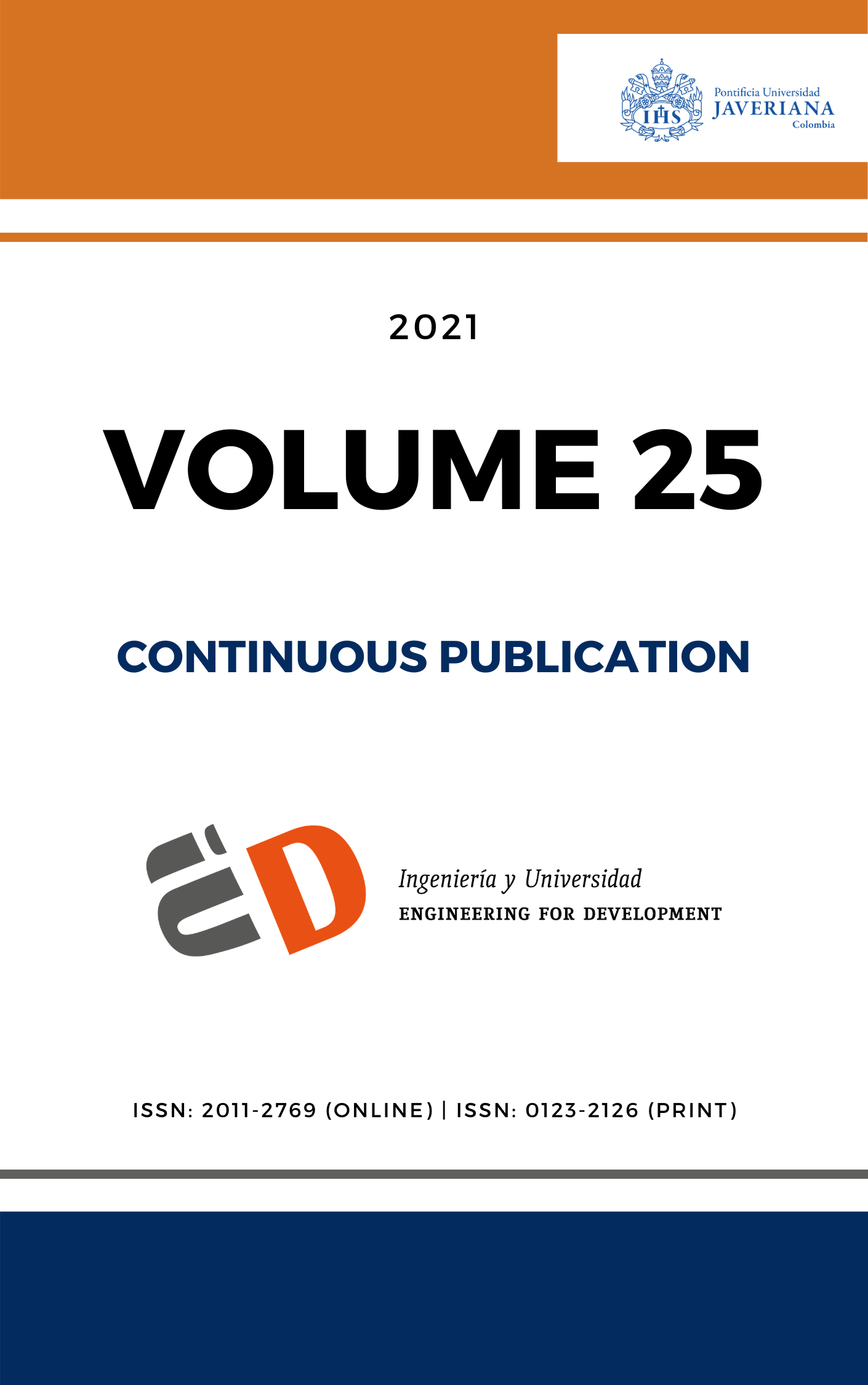Finding Installed Capacity For Practical Training Of A Designated Medical Specialty At A University Hospital
##plugins.themes.bootstrap3.article.details##
Objective: Propose a methodology to determine the number of medical students who can rotate, for the practice of medicine, in a university hospital, so that the quality of training processes and in-patient care are assured. Materials and Methods: A three-step procedure is presented, in order to find the number of students that the institution can accept simultaneously. Results: The method is based on an integer linear model and it was implemented to assess installed capacity of General Surgery service at Hospital Universitario Clínica San Rafael, increasing in two students (33 %) the training capacity. Conclusions: The proposed methodology not only guaranties the quality of training processes and in-patient care, but also generates other intangible results such as having a more agile way of planning, reducing the planification time. The methodology is easily extended to other services within hospitals.
Installed capacity, staffing problem, Scheduling problemcapacidad instalada, contratación de personal, asignación de turnos
[2] E. Álvarez and R. Salazar, “Hospitales universitarios y su implicación en la educación médica,” Rev. Med., vol. 35, no. 3, pp. 243–263, 2013. Available: https://revistamedicina.net/ojsanm/index.php/Medicina/article/view/102-7
[3] C. Mejía, “El concepto de la capacidad instalada,” 2013. [Online]. Available: http://www.planning.com.co/bd/valor_agregado/Julio2013.pdf
[4] A. Rais and A. Viana, “Operations research in healthcare: A survey,” Int. Trans. Oper. Res., vol. 18, no. 1, pp. 1–31, 2011. Available: https://doi.org/10.1111/j.1475-3995.2010.00767.x
[5] S. A. Angelo, E. F. Arruda, R. Goldwasser, M. S. C. Lobo, and A. Salles, “Demand forecast and optimal planning of intensive care unit (ICU) capacity,” Pesqui. Oper., vol. 37, no. 2, pp. 229–245, 2017. Available: https://doi.org/10.1590/0101-7438.2017.037.02.0229
[6] P. R. Harper and A. K. Shahani, “Modelling for the planning and management of bed capacities in hospitals,” J. Oper. Res. Soc., pp. 11–18, 2002. Available: https://doi.org/10.1057/palgrave.jors.2601278
[7] A. Kokangul, “A combination of deterministic and stochastic approaches to optimize bed capacity in a hospital unit,” Comput. Methods Programs Biomed., vol. 90, no. 1, pp. 56–65, 2008. doi: 10.1016/j.cmpb.2008.01.001
[8] F. F. Baesler, H. E. Jahnsen, and M. DaCosta, “Emergency departments I: The use of simulation and design of experiments for estimating maximum capacity in an emergency room,” in Proc. 35th Conf, Winter Simul. Driving Innovat., 2003, pp. 1903–1906.
[9] C. A. Amaya, N. Velasco, and S. Aguirre, “Planning and scheduling an emergency room workforce using linear programming,” Int. J. Math. Game Theory, Algebr., vol. 23, no. 4, p. 373, 2014.
[10] M. Erhard, J. Schoenfelder, A. Fügener, and J. O. Brunner, “State of the art in physician scheduling,” Eur. J. Oper. Res., vol. 265, no. 1, pp. 1–18, Feb. 2018. doi: 10.1016/j.ejor.2017.06.037
[11] V. L. Smith‐Daniels, S. B. Schweikhart, and D. E. Smith‐Daniels, “Capacity management in health care services: Review and future research directions,” Decis. Sci., vol. 19, no. 4, pp. 889–919, 1988.
[12] E. S. Buffa, M. J. Cosgrove, and B. J. Luce, “An integrated work shift scheduling system,” Decis. Sci., vol. 7, no. 4, pp. 620–630, 1976.
[13] C. E. Saville, P. Griffiths, J. E. Ball, and T. Monks, “How many nurses do we need? A review and discussion of operational research techniques applied to nurse staffing,” Int. J. Nurs. Stud., 2019. doi: 10.1016/j.ijnurstu.2019.04.015.
[14] K. L. Maass et al., “Incorporating nurse absenteeism into staffing with demand uncertainty,” Health Care Manag. Sci., vol. 20, no. 1, pp. 141–155, Mar. 2017. doi: 10.1007/s10729-015-9345-z
[15] M. Bam, Z. Zhang, B. Denton, M. P. Van Oyen, and M. Duck, “Planning models for skills-sensitive surgical nurse staffing,” 2017. Available: https://ssrn.com/abstract=2959005 or http://dx.doi.org/10.2139/ssrn.2959005
[16] A. Gunawan and H. C. Lau, “Master physician scheduling problem,” J. Oper. Res. Soc., vol. 64, no. 3, pp. 410–425, 2013. Available: https://doi.org/10.1057/jors.2012.48
[17] R. Bruni and P. Detti, “A flexible discrete optimization approach to the physician scheduling problem,” Oper. Res. Health Care, vol. 3, no. 4, pp. 191–199, 2014. Available: http://www.dis.uniroma1.it/~bruni/files/bruni14orhc.pdf
[18] H. D. Sherali, M. H. Ramahi, and Q. J. Saifee, “Hospital resident scheduling problem,” Prod. Plan. Control, vol. 13, no. 2, pp. 220–233, 2002.
[19] L. S. Franz and J. L. Miller, “Scheduling medical residents to rotations: Solving the large-scale multiperiod staff assignment problem,” Oper. Res., vol. 41, no. 2, pp. 269–279, 1993. Available http://dx.doi.org/10.1287/opre.41.2.269
[20] S. Topaloglu, “A multi-objective programming model for scheduling emergency medicine residents,” Comput. Ind. Eng., vol. 51, no. 3, pp. 375–388, 2006.
[21] S. Kraul, A. Fügener, J. O. Brunner, and M. Blobner, “A robust framework for task-related resident scheduling,” Eur. J. Oper. Res., vol. 276, no. 2, pp. 656–675, 2019. Available: https://opus.bibliothek.uni-augsburg.de/opus4/52399
[22] C.-H. Brech, A. Ernst, and R. Kolisch, “Scheduling medical residents’ training at university hospitals,” Eur. J. Oper. Res., vol. 274, no. 1, pp. 253–266, 2019. doi: 10.1016/j.ejor.2018.04.003
[23] MinSalud, Aproximaciones al Modelo de Relación Docencia Servicio: Modelo de Evaluación de las Prácticas Formativas. [Online]. Available: https://docplayer.es/25096383-Aproximaciones-al-modelo-de-relacion-docencia-servicio-modelo-de-evaluacion-de-las-practicas-formativas.html
[24] HUCSR, “Portafolio de servicios,” 2014. [Online]. Available: http://www.clinicasanrafael.co/hucsr/index.php?option=com_flippingbook&view=book&id=15&page=1&Itemid=260. Accessed on: June 01, 2017.
[25] MinSalud, Manual de acreditación en salud, ambulatorio y hospitalario, Colombia. Bogotá: Ministerio de la Protección Social, 2011. Available: https://www.minsalud.gov.co/sites/rid/Lists/BibliotecaDigital/RIDE/DE/CA/manual-acreditacion-salud-ambulatorio-hospitalario-2011.pdf

This work is licensed under a Creative Commons Attribution 4.0 International License.


